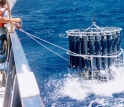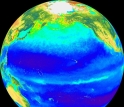News Release 04-106
The Power Of One: Unicellular Organisms Contribute More Nitrogen To Ocean Than Reported Earlier, Affect Global Atmosphere

Scientist Joe Montoya works with a researchship's winch operator to remove slack from a conduc ...
August 25, 2004
This material is available primarily for archival purposes. Telephone numbers or other contact information may be out of date; please see current contact information at media contacts.
ARLINGTON, Va.—Large, nutrient-poor expanses of the open ocean are getting a substantial nitrogen influx from an abundant group of unicellular organisms that "fix," or chemically alter, nitrogen into a form usable for biological productivity.
First identified about five years ago, these organisms – about 7 microns in diameter – are fixing nitrogen at rates up to three times higher than previously reported for the Pacific Ocean, according to research funded by the National Science Foundation (NSF) and published in the Aug. 26, 2004, edition of the journal Nature.
"To our surprise, these unicellular nitrogen-fixers are broadly distributed spatially and vertically distributed at least down to 100 meters, and they're fixing nitrogen at quite high rates," said Joe Montoya, a biologist at the Georgia Institute of Technology and lead author of the paper. "The rates we measured imply a total input of nitrogen that exceeds the rate of nitrogen fixation measured for the cyanobacteria Trichodesmium [traditionally believed to be the dominant marine nitrogen-fixer] in the Pacific Ocean. These 'unicells' are the largest single source of nitrogen entering the water in broad areas of the ocean."
This level of nitrogen fixation in the Pacific Ocean alone accounts for about 10 percent of the total global oceanic new production of biomass, according to the researchers' preliminary calculations.
"This is an important finding that helps us understand the ocean's nitrogen cycle," said James Yoder, director of NSF's division of ocean sciences, which funded the research. "The nitrogen cycle is one of the keys to understanding the role of ocean biology in the global carbon cycle."
Carbon dioxide is one of the naturally occurring gases that traps energy from the sun and helps maintain hospitable temperatures on Earth, creating the "greenhouse effect." But studies indicate that greenhouse gases that form from vehicle and industrial emissions are enhancing the greenhouse effect and contributing to global climate warming.
The research effort is increasing scientists' understanding of the fertility of the ocean. "This group of tiny, photosynthetic organisms, whose contribution to the fertility of the ocean is significant, appears to play a critical role in driving the movement of elements through the ocean both in the upper layer of the water and from the atmosphere into the ocean," Montoya said.
The nitrogen-fixation rates reported in Montoya's study are conservative figures, according to the paper. The scientists interpreted the data based on the assumption that unicells are only fixing nitrogen for 12 hours a day – a common pattern for other nitrogen-fixing organisms. But some of their data indicate that unicells may actually fix nitrogen around the clock. "We may be underestimating the true rate of nitrogen fixation by a factor of two," said Montoya.
Montoya first began his research five years ago with co-author Jonathan Zehr, a biologist at the University of California at Santa Cruz. The other co-authors are Georgia Tech graduate student Carolyn Holl, University of Hawaii graduate student Andrew Hansen, University of Texas at Austin marine scientist Tracy Villareal and University of Southern California marine scientist Douglas Capone.
The scientists will continue to survey the Pacific Ocean, as well as the north Atlantic and the south Pacific Oceans in two research cruises in 2006 and 2007. In addition to collecting more detailed nitrogen-fixation rate measurements, the researchers will conduct manipulation experiments to determine whether phosphorus, iron or another environmental factor is playing a role in determining the abundance, distribution and activity of the unicells, Montoya explained.
In the south Pacific, Montoya expects to find high rates of nitrogen fixation by unicells, he said. Measurements already taken in the marginal waters of the South Pacific – off the coast of northern Australia – yielded the highest recorded rates of nitrogen fixation by unicells to date.
There are still numerous regions of nutrient-poor oceans – typically off the continental shelves from the equator north and south to about 40-degrees latitude – in which little or nothing is known about unicellular nitrogen-fixing organisms, Montoya noted. "We are still at a very early stage in understanding ocean science and how things work in these enormous pieces of the ocean."
-NSF-
-
Scientist Joe Montoya pulls the slack out of the conducting cable attached to his research's tea ...
Credit and Larger Version -
Researchers sampled the ocean water with a CTD-rosette, which consists of an aluminum frame, a s ...
Credit and Larger Version -
In this map of the Pacific Ocean, the deep blue areas are the nutrient-poor and low-fertility ce ...
Credit and Larger Version
Media Contacts
Cheryl Dybas, NSF, (703) 292-7734, email: cdybas@nsf.gov
Program Contacts
Phil Taylor, NSF, (703) 292-8580, email: prtaylor@nsf.gov
The U.S. National Science Foundation propels the nation forward by advancing fundamental research in all fields of science and engineering. NSF supports research and people by providing facilities, instruments and funding to support their ingenuity and sustain the U.S. as a global leader in research and innovation. With a fiscal year 2023 budget of $9.5 billion, NSF funds reach all 50 states through grants to nearly 2,000 colleges, universities and institutions. Each year, NSF receives more than 40,000 competitive proposals and makes about 11,000 new awards. Those awards include support for cooperative research with industry, Arctic and Antarctic research and operations, and U.S. participation in international scientific efforts.
Connect with us online
NSF website: nsf.gov
NSF News: nsf.gov/news
For News Media: nsf.gov/news/newsroom
Statistics: nsf.gov/statistics/
Awards database: nsf.gov/awardsearch/
Follow us on social
Twitter: twitter.com/NSF
Facebook: facebook.com/US.NSF
Instagram: instagram.com/nsfgov





